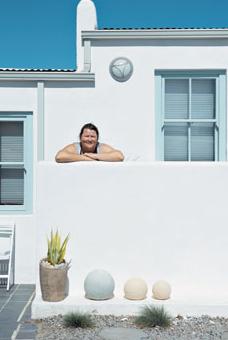Suzi Holtzhausen is in love with her fisherman’s cottage on the West Coast, and locals are in love with her indigenous dishes.
By Hilary Prendini Toffoli
 You can always expect the unexpected with Suzi Holtzhausen. I imagine it’s something to do with all that restless energy. She’s a perpetual-motion machine, constantly dreaming up the next dish, her novel ideas backed by prodigious talent and training. But everything she makes, she says, is based on one grounding philosophy. “A long time ago, when I was cooking at Cybele Forest Lodge, Barbara Jeffries told me: ‘Give people what they love, but with a bit of an edge. Some unusual ingredient they don’t expect’. I’ve been doing that ever since.”
You can always expect the unexpected with Suzi Holtzhausen. I imagine it’s something to do with all that restless energy. She’s a perpetual-motion machine, constantly dreaming up the next dish, her novel ideas backed by prodigious talent and training. But everything she makes, she says, is based on one grounding philosophy. “A long time ago, when I was cooking at Cybele Forest Lodge, Barbara Jeffries told me: ‘Give people what they love, but with a bit of an edge. Some unusual ingredient they don’t expect’. I’ve been doing that ever since.”
She’s done time in plenty of kitchens since then, including Sabi Sand and Kruger Park lodges, but it was her own Johannesburg cookery school – the Barnes Street Culinary Studio –that really put her on the map. She ran the school for 15 years, during which time she preached a surprisingly down-toearth culinary gospel.“One of the things I used to tell my students was that if your menu says the sauce is flavoured with fenugreek, you’d better make sure it is. How often do you find yourself eating something in a restaurant that doesn’t taste like the menu said it would?”
Brought up in Cape Town and trained at Silwood Kitchen, Suzi always wanted to return to the Cape. So she was ecstatic when she found an old fisherman’s cottage in Paternoster, a village whose tidy whitewashed cottage ethos suggests the isles of Greece rather than the general wildness of the West Coast. She called the restaurant Gaaitjie, which means “little hole”. With reed ceilings and thick walls of sand, shell and stone, it seats only 30 people, but is perfectly located on the rocky edge of the ocean where fishing boats come up on to the beach. Suzi rents the place from Paternoster Fisheries. “My manager Laetitia grew up in this house. Aerial photographs show that it has been here for ages. This was the original kitchen with the original hearth, and I kept it in the middle of the house where people walk past to the main room. As Ferran Adria says, people like to see you cooking.”
Naturally, seafood is always on the menu. Cultivated oysters and mussels from Saldanha are a staple. Suzi’s snoek lasagne is legendary and has even been mentioned in the New York Times. But along with an increasing number of restaurateurs, she is concerned about sustainable fishing. “From Sea Harvest we sometimes get the by-catch, what they don’t process and would have thrown away. The supplier will phone and say ‘I’ve got octopus, mackerel, whatever’. Our crayfish is from Paternoster Fisheries, properly caught and on the quota system. I get upset when visitors buy crayfish in berry out of season from the outjies on the side of the road who’ve simply brushed off the berries.
The season is mid-November to mid-April and we should all stick to that.” Sourcing what is available and seasonal means Suzi sometimes serves food that you wouldn’t typically find on a restaurant menu. “Because we’re not blessed with exceptional bounty from the ocean, we present it in an earthy way, often combining it with meat, such as grilled beef with alikreukel and a red wine butter, white mussels with pork, marinated oysters with bacon, or harder with lamb kaaings (fried strips of lamb rib meat). Harder is one of my favourite fish. It’s not as oily as the sardine, and you get a nice meaty little fillet. Locals only need to look at the moon to know when they’ll find harders. Kaaings are eaten in these parts as a snack and they fit in with our policy that every part of the animal should be used.”
She goes equally West Coast on desserts. Boere treats like witblitz strawberries with warm chocolate tart, melktert spiced with cardamom and gooseberries and tameletjie (praline) pieces with grape and tarragon muscadel jelly.“The slight tartness of the lemoncurd, which must be home-made, goes well with the sweetness of the grapes and jelly. You should always end with something fruity.”
Gaaitjie is on St Augustine Road in Paternoster. Call 022-752-2242. Open Thursday to Monday for lunch (12:30 to 2pm) and dinner (6:30 to 10pm).
SOURCES
By Bruce Tuck









![CHEF HUGO UYS’ 5 BEST [OF NEW YORK] - February 2019 CHEF HUGO UYS’ 5 BEST [OF NEW YORK] - February 2019](https://www.foodandhome.co.za/app/uploads/2018/09/Chef-Hugo-Uys-5-Best-150x150.jpg)